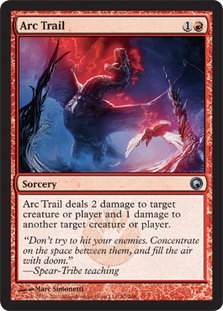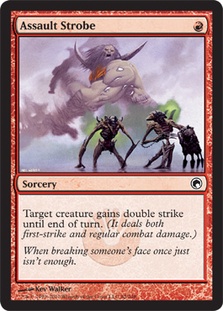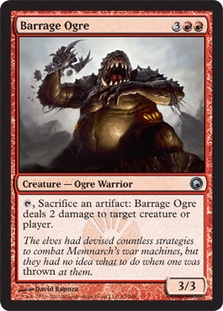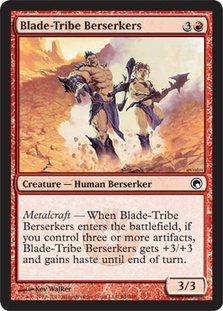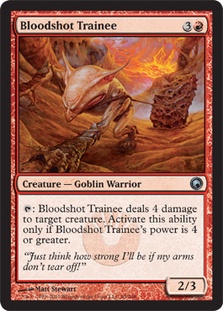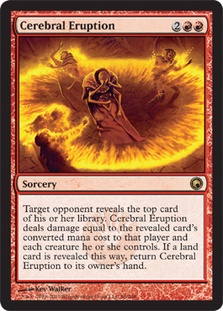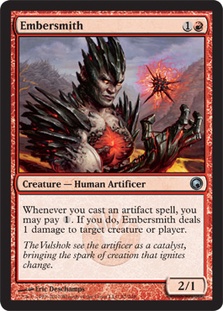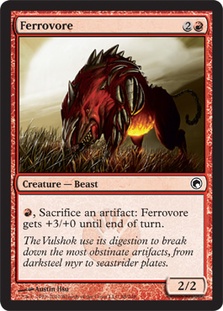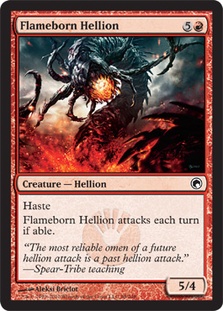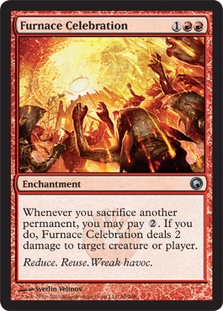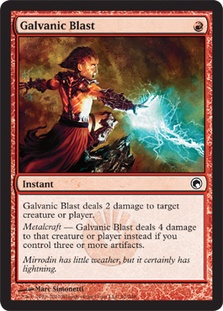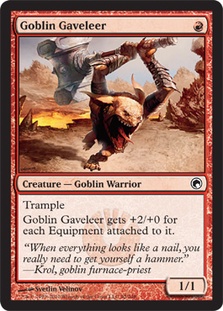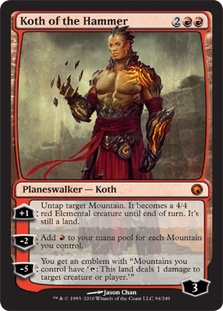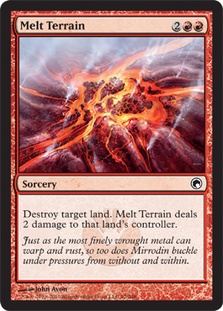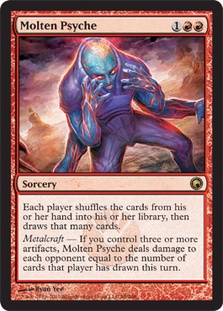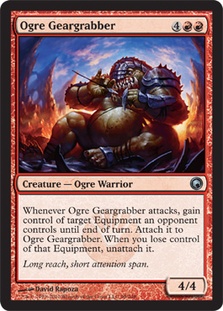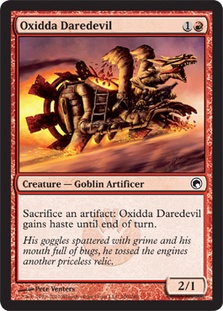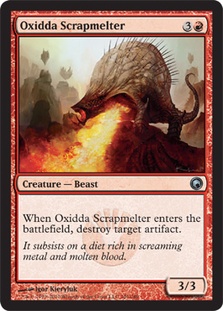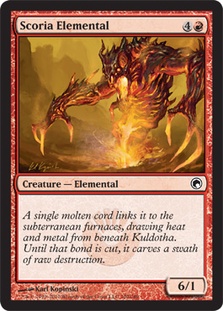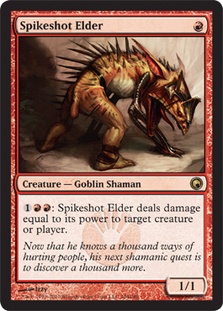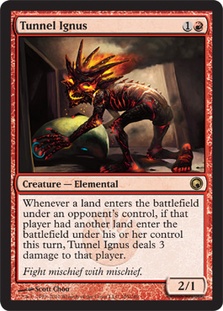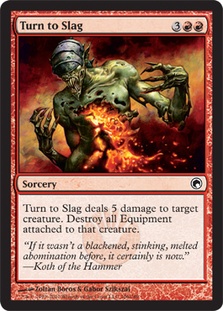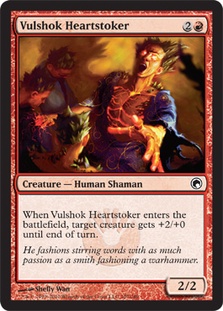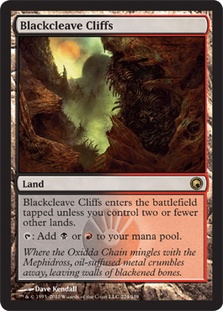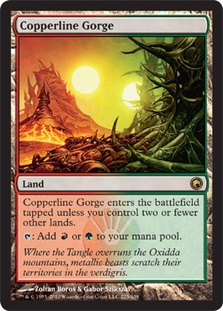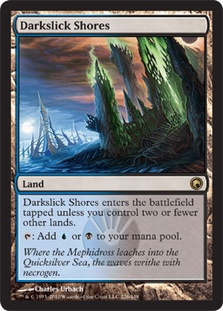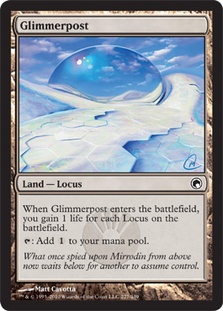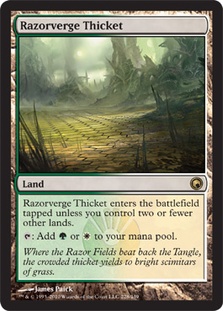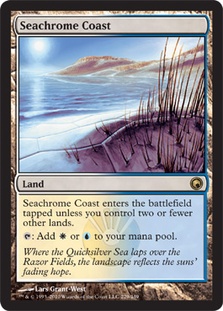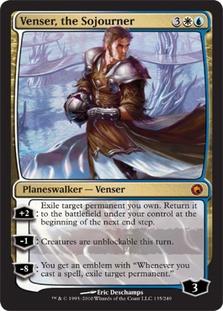Welcome to chapter three of my novel, entitled
The Scars of Mirrodin Set Review.
Chapter one (the first 44 artifacts) can be found
here, and chapter two (artifacts 45-88) can be found
here.
In case you aren’t familiar with the format, I’m not a fan of rating cards.
The relative values change a lot as the format evolves.
Instead, I’m going to talk about possible applications of every card that does something well.
There are some cards that are “strictly worse” (#mindslavercheck) than existing cards, so I’ll point out why they won’t work.
I’m much more interested in what can be done than trying to guess what the best deck is, at this point (though today we’ll talk about two of the top five cards in the set).
Today we’re covering Red, Land, and Artifacts (Green has been moved to tomorrow).
And we are off, like a
herd of turtles!
Red
At first glance, one might be tempted to write Arc Trail off as just another awesome Limited spell that won’t impact Constructed due to not being able to consistently kill two creatures.
However, further examination reveals that the target is templated just right for Constructed players to be able to count on it.
You can target yourself!
As a result, you can always at least count on getting two damage in, even if your opponent’s deck is creatureless.
Â
Arc Trail is kind of to Volcanic Hammer as Forked Bolt is to Shock.
Forked Bolt is a sorcery, instead of an instant like Shock, but Arc Trail does have a bit of a targeting restriction compared to Volcanic Hammer.
It’s easy to see that Arc Trail is at its best when it hits a one-toughness creature and a two-toughness creature, such as Birds of Paradise and Fauna Shaman or Goblin Guide and Plated Geopede or Memnite and Glint Hawk.
Killing two one-toughness creatures is still totally amazing, and you still get value out of it when you hit
only
one creature and get an extra damage or two in to the opponent’s dome.
Another interesting factor to consider is that there’s only Searing Blaze and Pyroclasm for competition for two-cost burn, both of which
need
your opponent to have creatures, whereas there’s a ton of good one-cost burn (Lightning Bolt, Burst Lightning, Galvanic Blast, Forked Bolt).
Â
I fully expect Arc Trail to become a Standard staple.
Every red mage will get a lot of mileage out of a playset, but on top of that, it’s the type of card that some non-red decks, like perhaps U/W, splash.
Does your U/W deck have trouble with Fauna Shaman decks?
This card might help those matchups a bit…
In Limited, I’d often first-pick Arc Trail if it cost twice as much to cast.
Berserk has long been a fan favorite, and for the past sixteen years, poser after poser has attempted to fill the desire for another Berserk.
Surge of Might was so far from playable it was unreal, but Fling, Soul’s Fire, and Fatal Frenzy have all been respectable, though none costing one.
Finally, we have a one-mana Berserk and it’s actually good!
Assault Strobe doesn’t have Berserk’s “drawback” of killing the creature; however it does put a cap on doing it to a creature effectively once (whereas the second Berserk was usually way stronger than the first), and Assault Strobe is only a sorcery, making it harder to surprise people with it.
As such, it seems pretty unlikely to make the grade in most Draft decks.
That said, if you’re just trying to
clock a goldfish
in Constructed, Assault Strobe does a fine job, and since it doesn’t kill the creature, you can actually do it two turns in a row, if that’s what it takes.
Personally, I think the greatest shot of an Assault Strobe deck is in some sort of infect deck with a lot of pumps spells, as infect is like getting to Berserk your Berserked creature for free anyway!
Turn 2 Blight Mamba or Plague Stinger or Necropede or Ichorclaw Myr
Turn 3 Groundswell or Vines of Vastwood or equip a turn 1 Adventuring Gear, Assault Strobe for the full ten poison counters!
That is one of the least inconsistent turn 3 kills in Standard I’ve seen.
You can play so many copies of two-drop infect creatures, you really don’t need to worry about that element.
There are also so many good ways to +4/+4 that you don’t have to worry too much about that end either.
This sounds like a pretty insane opening, but it isn’t even that lucky.
Besides, all of the other cards are all fine on their own.
For instance:
Â
Creatures (18)
Lands (24)
Spells (18)

Of course, it may be that Assault Strobe is too cute, here, and should just be interactive cards, or perhaps different equipment, more guys, or even Boar Umbra.
Either way, you see what I’m getting at.
Infect is very powerful, and I think the key to abusing it is to push the “double strike” angle as far as we can.
For more on how to do this to an extreme in Legacy, check out Matt Sperling Eternal set review
here
.
While Barrage Ogre is at least two mana away from being a Constructed consideration for anyone, he’s actually a totally killer in Limited.
He has a substantial body, for the format, and turns each of your Myr into Shocks, which is very nice.
Once you start throwing Spellbombs, you’re starting to talk real value, as you still get to draw the card.
Throwing Perilous Myr is probably my favorite, though I’d be happy to throw any random artifact that has run out of charge counters.
He’s a five-drop, but he totally dominates the board and doesn’t cost mana to use. A big part of the reason I avoid most of the expensive cards is because I want to make sure I have space in my curve for cards like this.
I imagine players won’t initially value him highly enough, but as soon as “official pick orders” start circulating, he’ll quickly move up on everyone’s list.
Suffers from KCC Syndrome (
Koth’s Casting Cost Syndrome).
As such, not for Constructed.
I suppose you could just be
that
sure that you’ll always have metalcraft, meaning he is a 6/6 haste creature on the turn he comes out, but the fact that he shrinks back down plus doesn’t have haste makes me doubt you’d even want him then.
Limited, is another story, however.
There seems to be a good red aggro deck that can be drafted that uses lots of artifacts.
I can’t yet say the right way to build it, but the Blade-Tribe probably plays a role.
Even if you just jam it in your deck, it’s a Hill Giant that might occasionally get a bonus.
Nothing special, but could be sweet in the right deck.
This Future Shifted reprint (finally print?) is a very appropriate card for this world.
His body is actually a nice size for the type of creature he is, and there are a variety of options for powering him up, ranging from equipment, to pump spells, to cards like Vulshok Heartstoker and Painsmith.
Bloodshot Trainee takes a little work, but he pays you off very well for your trouble.
Light years from Constructed, as the last thing you want is to spend two cards to make a four-drop’s power hit four, only to not attack with it.
Spikeshot Elder is far better at anything this guy could ever try to do.
How much damage would you have to deal on average to be worth it to play Cerebral Eruption?
Well, at four mana, I suppose you could get away with dealing three damage to your opponent and each creature they control.
Which is not an unrealistic reveal; however the problem is that Cerebral Eruption is unreliable.
When you want to play your sweeper, you want to play your sweeper
now.
How many spells that cost three or more could your opponent possibly be playing?
What if you hit a land?
Do you have that kind of time?
The counter-argument is that you don’t three against everyone, just the right amount.
For instance, against Naya, you’ll often
be able to get away with only one or two.
Here, you’ll often be better than 50% to hit, but that is still horribly unreliable.
Don’t even waste the time against Affinity, which often features eleven zero-drops, and lots of one-drops and two-drops that don’t necessarily die to one damage, sometimes even two.
As a burn spell against a creatureless opponent, it would need to deal five damage to even be a consideration (as Lava Axe isn’t even close to seeing play at five mana), but not even Eldrazi Green will let you average those kinds of numbers.
This card’s value could change if cards were printed that let you easily look at the top of your opponent’s library, or your opponent was incentivized to show you his, but as it stands, you’re pretty much limited to Goblin Guide and Jace, the Mind Sculptor.
Goblin Guide is a reasonable combo and is probably Cerebral Eruption’s best chance of play (remember, the Eruption doesn’t hit you or your creatures).
If you’re Jace-ing, it’s not clear why you need an unreliable value sweeper, though I guess it’s an option, now that Earthquake is gone.
Still Pyroclasm is probably a bit better.
Embersmith is a total monster in Limited, functioning as a Cunning Sparkmage in many instances, but also doing beatdown duty.
His one-toughness leaves him exceptionally vulnerable in this format, but he’s excellent while he lasts.
When your good cards are cheap, you’re going to have such an advantage in this format.
It’s cards like this that help make random Myr and Spellbombs raise their stock a bit (and other “good” expensive cards drop a similar bit).
As fun as Embersmith is, I don’t imagine he makes much of an impact on Constructed, save maybe Block Constructed, despite the fact that he’s
miles better than any creature in any Sligh deck ever.
There are just too many good two-drops for Red to choose from.
Kargan Dragonlord, Plated Geopede, Ember Hauler… the two-drops do not play around, these days.
This is a much more exciting way to sacrifice artifacts than Oxidda Daredevil in Limited.
I like the second point of toughness here a lot, as well, as there are a lot of infections going around — not to mention Myr 1/1s.
While you may not always get to connect with Ferrovore, it makes cards like Flight Spellbomb a lot more potent.
In addition, he can trade up against fatties, if it ever comes to that.
His power level is nothing exciting, but he’s a good card in the right decks and reminds us that Scars is all about synergy.
Not that far from Constructed, but unfortunately, pretty surely at least one step away from being worth it.
He’s no Atog; he is not even a Kiln Fiend.
At least two mana away from Constructed consideration, as he’s just a worse version of twenty other creatures (Hellkite Charger, for instance).
A fine Limited monster, since haste is good, but his numbers aren’t amazing.
It’ll take experience to determine how valuable fatties are in red, but I’m generally a bit hesitant to pick up high-cost cards, as they’re a dime a dozen in this set, and it’s the cheap ones that really give you the best edges this time (outside of removal and bombs).
This card actually reminds me quite a bit of Lightning Rift, though it does cost a mana more to cast, as well as to activate.
It has chances in Constructed, primarily in conjunction with fetchlands, including Terramorphic Expanse.
It also triggers off of completed Expeditions and Quests, Kuldotha Rebirth, Bloodthrone Vampire, and more.
I’m not sure what sort of deck would get the most mileage out of it, but I’d guess some sort of midrange deck with plenty of creatures with
Furnace Celebration in moderation as a late-game plan.
Perhaps some deck with Bloodghast, Reassembling Skeleton, and Culling Dais?
Maybe Horizon Spellbomb and Mitotic Slime?
It’s possible that a control deck might use this, but they have so many bigger possible plans that I’m skeptical.
How many players will be able to deal with enchantments is as-of-yet unknown, though Revoke Existence and Reclaim are certainly being discussed, not to mention Into the Roil, All Is Dust, Ratchet Bomb, and so on.
The power is there to make this a possibility; it’ll just come down to what other interactions work best together.
I know that is not the most useful for having a list in your hands today, but the point of this review is to discuss which cards are worth further consideration and which aren’t.
Furnace Celebration has good chances of not panning out, but it does have real chances of being good, unlike a lot of other cards.
In Limited, this card is awesome.
It isn’t the fastest card in the world, but it gives you good value over time.
Shocks go a long way in this format and being able to buy Shocks every time you play a Spellbomb or Replica is exactly what I want to be doing.
This doesn’t even factor in all of the ways red has to sacrifice artifacts, making your Myr especially live.
Slow, powerful stuff is a dime a dozen in this format, but this is one of the better options, outside of broken rares.
Continuing the latest in a long line of absolutely incredible Lightning Bolt variants, Galvanic Blast is actually very easy to compare to Burst Lightning.
If you don’t
try,
then it’s obviously just a Shock, but if you incorporate it in a deck full of Everflowing Chalices, Contagion Clasps, Wurmcoil Engines, Pilgrim’s Eyes (runner up for the “Most Improved Award,” behind Quest for the Holy Relic), and so on, you’re talking about a serious savings of mana.
Burst Lightning and Galvanic Blast kill early threats equally well, but kicking Burst Lightning was most often a way of sending damage to the face late.
Galvanic Blast works extremely well in this capacity, as it lets you fire off a devastatingly lethal barrage at once, totally bottlenecking your opponent on mana, much in the same way they usually do to you with your Burst Lightnings when you finally draw your fifth land.
Basically, if you’re in the market for Burst Lightning, Galvanic Blast is better if you can support it.
In fact, if you can support it, it’s probably better than Lightning Bolt.
Outside of just being an awesome burn spell, some ambitious minds are sure to try to combo it with Quest for the Pure Flame.
T1 – Mountain, Mox Opal, Memnite, Memnite, Quest for the Pure Flame, Goblin Guide
T2 – Mountain, attack, activate Quest, Galvanic Blast, Reverberate!
Because if you’re on the draw and have these nine cards, you can kill turn 2!
All jokes aside, Galvanic Blast is an extremely mana efficient burn spell and will be an excellent staple.
He also is awesome in more powerful formats, if you play a fair number of artifacts and are in the market for a better Lightning Bolt.
Galvanic Blast is, of course, a sweet Limited removal spell as well.
I love the tempo associated with it, as it’s exactly the kind of removal spell I want in this format.
The possibility of building a three-power creature for one mana (not to mention the bonus it gets from whatever Gear you give it) is very enticing.
The trample is just gravy, helping pay us extra for going to the trouble.
Since Goblin Gaveleer obviously requires a lot of equipment, I assume the first place to start working with it is a Boros deck with Steppe Lynx, Spikeshot Elder, Plated Geopede, Stoneforge Mystic, Adventuring Gear, Cunning Sparkmage, Basilisk Collar (nice combo with trample!), and whatever other miscellaneous equipment you use, as well as some removal.
Just make sure you use 25 lands!
Dedicated landfall decks need to hit their land.
Anyway, I think Goblin Gaveleer is a superior Kor Duelist, on account of its ability to keep stacking, as well as the added value of trample.
That said, Kor Duelist does hit a little harder with a single Adventuring Gear — though Gaveleer loves him a Collar.
I wonder if you could use both and just play an unusually high number of pieces of equipment?
Another possibility is to put Goblin Gaveleer in some sort of Kuldotha Rebirth deck which might want all that equipment laying around to sacrifice to it while also playing Goblin lords to pay you the other way.
This one is a bit of a long shot, but it could surprise some people.
I’m not sure how to evaluate him in Limited yet, as it’s clearly a function of how many pieces of equipment I can reliably get, as well as which ones I’d actually want to play.
I assume he’s one of those cards that goes late since most drafters can’t use him, but he’s unreal in the one deck that can use him, helping shape a sick Draft archetype that will be the secret tech at Grand Prix Nashville.
How is this fair?
I get that it’s a rare, but man, this is just brutal in Limited.
I kind of wish this were a mythic so it would ruin less games.
It’s even a non-artifact with five toughness, ensuring that there are a lot less answers to this guy than most broken rares.
This is a very good candidate for best card in the set.
Molten-Tail Masticore and Wurmcoil Engine can fit in any deck, but
they’re artifacts, even if they do have protective abilities.
Hoard-Smelter Dragon is certainly in their league.
He kills really, really fast and destroys permanents left and right while still attacking.
At the Prerelease, I killed someone’s Clone Shell in combat with a hand containing Trigon of Corruption, Clone Shell, Skinrender, Ratchet Bomb, and Rusted Relic to my opponent’s three cards in hand.
“What’s the worst that could happen?”
I found out.
As far as Constructed goes, Hoard-Smelter Dragon has chances, particularly as a sideboard card, but the problem is that between Wurmcoil Engine and Inferno Titan, you don’t exactly want for six-drops.
Add to this Destructive Force and Steel Hellkite, and you’re talking a lot of tough, competitive options.
Worth considering, but I wouldn’t bet on him.
Without a doubt the most talked about card in the set, Koth is a pretty epic planeswalker that I think may prove to be the second most powerful planeswalker printed to date. Jace, the Mind Sculptor is an easy number one — and not just because of my man crush, but Elspeth, Knight-Errant and Koth of the Hammer is an interesting debate, not to mention Ajani Vengeant being no slouch.
Evaluating Koth starts with a look at the relative value of each of his abilities.
Let’s compare him to the harder-to-cast Ajani Vengeant.
Â
Round 1
If Ajani’s plus ability were printed as a cantrip sorcery for W, it’d see a lot of play, but if it cost 1W it probably wouldn’t see any.
If Koth’s ability were printed as a cantrip sorcery for 1R, it’d be a four-of in every red deck.
Winner: Koth by a mile.
Round 2
Ajani’s second ability is a good deal on a card that cost RW.
(Lightning Helix is an instant, but Ajani Vengeant’s ability actually functions as a sorcery.)
No question, people would use a card that cost RR that added R to your mana pool for every Mountain you controlled.
Winner: It’s close, but I gotta give it to Ajani Vengeant, as his ability to protect himself is much appreciated, whereas Koth’s red mana ability has power through the roof, but is not always well spent.
Round 3
Both of these walkers have absolutely incredible ultimates that totally warp the way your opponents have to play against you, as both are usually fatal, and both are a regular part of the walker’s plan, not just an afterthought.
Ajani Vengeant’s ultimate might translate into a
slightly higher win conversion than Koth’s (both are pretty high), but Ajani ultimates on the fifth turn of use, whereas Koth needs only three.
As such, I have to give the edge to Koth without question.
That’s a really short clock for an ultimate that translates into victory so often.
While I think each of Koth’s abilities are stronger in terms of effect, there’s no question that Ajani was always good at protecting himself.
While this is a strike against Koth, it’s also a warning that if you can’t attack planeswalkers, Koth is going to blow you out.
Koth will find a ton of homes, as he is so off the charts in terms of power — he’ll bend the format around him to make them exist for him to inhabit.
Some have raised fears that he’d be merely a Kargan Dragonlord: powerful, but only found in a single Tier 2 deck.
Koth will open up for more places than Mono-Red Aggro, however.
Big Red decks with Wurmcoil Engines and possibly Destructive Force will emerge that take advantage of all three of his abilities quite well.
In fact, there’s an entire spectrum between Big Red decks that may or may not use a lot of artifacts and fast red decks that use Goblin Guide.
Koth adds a lot to everyone.
Two-color decks will seek to exploit him, as well.
Whether these decks are R/w, R/u, or R/g — that remains to be seen, but one thing I’m pretty sure about:
Koth of the Hammer is the best card in Scars of Mirrodin and one of the best planeswalkers of all time.
Koth does have far fewer applications than Jace, and there are a lot of other quality rares, so I don’t imagine his price climbing, but he is the real deal and well worth working heavily with.
If your deck has thirteen or more Mountains or ways to fetch Mountains in it, you should try Koth.
He’ll cross over to Extended; though his influence on Vintage and Legacy will surely not match Jace’s, haha.
Obviously completely broken in half in Limited (where your opponent is on a razor-thin two-turn clock to deal with him, lest they be ultimated out).
The subject of a bit of controversy; some have praised the Phoenix as a top card in the set, while others relegate him to the bulk section.
The answer is somewhere in the middle, as it often is.
I think Kuldotha Phoenix will find a variety of homes, though I don’t think he is top ten in the set by any stretch.
Some possible homes:
1) Big Red
He will probably be used at least as a two-of in Big Red decks, as playing all six-drops is just not smooth.
Wurmcoil Engines, Everflowing Chalice, Contagion Clasp, Pilgrim’s Eyes, and Ratchet Bomb give plenty of reasonable ways to trigger the Phoenix on your upkeep.
2) Some Dredgevine decks
His applications in such a deck are obvious, but what no one has solved yet is how to play enough artifacts that you’d actually want to metalcraft him.
Trinket Mage, Hedron Crab, Fauna Shaman, and Vengevines are all amazing cards for the deck, but none of those are artifacts.
Even if you add Memnites and promise yourself that by the time you’re done, Mox Opal will work, you’re still pretty far from metalcrafting.
How many Trinkets are you really going to play?
You can try to get their artifact creatures, like Molten-Tail Masticore, Lodestone Golem, Perilous Myr, and Pilgrim’s Eyes, or you can try being on some crazy Grindclock type of time.
3) Blue-Red tempo (maybe control)
This type of deck will naturally want plenty of artifacts, especially if it’s built around Trinket Mage + Cunning Sparkmage + Basilisk Collar.
Outside of all the Trinkets, you also have all the same artifacts from Big Red above.
It’s tempting to use Argent Sphinx in this sort of a deck as an unkillable victory condition, but there’s a lot more creature-on-creature combat, so the Sphinx is less appealing compared with the Phoenix (which can actually brawl, die, and return).
Also, I really love haste.
A lot.
He’s difficult to cast in Limited, but certainly a first pick bomb rare if you can cast him.
There are so many bomb rares in this set, it’s tempting to fear that bombs will settle most games of Limited, but I think that is far from accurate.
My
intuition is that, as we learn the set, we’ll learn to draft fast enough decks that the impact of bombs will be greatly diminished.
I don’t think we’re going to end up at Zendikar speeds, fortunately.
Making three-power worth of creatures (and Goblins to boot) for one mana is definitely something that I’m interested in hearing more about, so what is the catch?
Playing a lot of Memnites, Ornithopters, and maybe Mox Opals, not to mention whatever other artifacts it takes to power Mox Opal?
If you pull off the combo, it’s pretty good, but it really does want you to have a way to power your guys up to make sure all those 1/1s are actually hitting.
Nobody likes a Stoneforge that stops your entire offense by itself.
You can go to all the trouble of playing Spellbombs, but once you’re paying three mana to make three guys, how much are you doing really?
Perilous Myr?
Now you’re talking; though you’re still talking about two cards and three mana.
Creatures (26)
- 4 Goblin Chieftain
- 2 Goblin Bushwhacker
- 4 Goblin Guide
- 4 Warren Instigator
- 4 Ember Hauler
- 4 Memnite
- 4 Spikeshot Elder
Lands (23)
Spells (11)

While this adds up to a workable starting place, I’m not so sure the Kuldotha Rebirth element is as good as just being a dedicated Goblin deck. For instance, what if you cut most of the artifacts and Rebirths and just added Koths and burn?
Perhaps the more exciting application for Kuldotha Rebirth is triggering Beastmaster Ascension.
It’s certainly a Magical Christmas Land kind of plan, but what if you build a R/G Tokens deck that just wanted to trigger the Ascension
really fast?
It is even possible that such a deck would want blue for Trinket Mages, Jace, the Mind Sculptors, Unified Wills, and an abundance of fetchlands anyway.
This one would need some love to make work, but it’s actually kind of exciting.
The biggest point against it, though, is that there seem to be a lot of super-fast creature-swarm nut draws.
If that’s the case, than cards like Pyroclasm, Ratchet Bomb, and Day of Judgment are going to be quite prevalent.
There are plenty of Limited decks where I’d play Kuldotha Rebirth, as it‘d primarily be a function of having enough Perilous Myr, Spellbomb-type cards.
It also works fine with artifacts that you pull all the charge counters off of, as well as Myr that have outlived their usefulness, and artifacts that belong to your opponent (that you’re borrowing until end of turn).
Roiling Terrain doesn’t see that much play, and Melt Terrain only wishes it was a Roiling Terrain.
That said, you know there are always those people that are hellbent on building Land Destruction decks, even if they have to play sixteen four-drops to do it.
If you aren’t one of those people, remember the golden rule.
This card doesn’t have a gold symbol or higher, so it doesn’t get to make the rules.
I don’t expect this Limited format to be one where Melt Terrain will see much play at all, either.
There are too many cycling cards, alternative mana sources, and possible fast starts.
It just doesn’t seem worth it.
You want to
see
terrain
melting?
I
will
show
you
terrain
melting!
Winds of Change isn’t very good at one, let alone three, so we’re going to have to get paid off of metalcraft.
Assuming we go to all of the trouble of building a metalcraft red deck (which isn’t actually that much of a stretch), we get what?
A sorcery-speed Sudden Impact for three instand of four?
That hardly seems worth it.
Now, what if we got a little more combo-rific with it?
Runeflare Trap gives you another Sudden Impact — this time for only one mana, and you can even trigger it from the Molten Psyche.
We’re starting to talk about a serious blow to the dome.
Unfortunately, it would appear that the format is going to continue to be far too fast for these sorts of antics.
People are just going to be able to get cards out of their hands!
Seems wretched in Limited, despite its rarity, for what it’s worth.
“Let Me Get That Up Off Ya, Playa!”
“Get Over Here!
No, Not You, Your Gear!”
“I Was Gonna Give It Back…”
“Everything I Know About Geargrabbing, Learned in Kindergarten.”
“He’s An Ogre, What Did You Expect?”
“Argentum Armor, huh?”
“Who Said Red Isn’t The Color Of Sharing?”
This isn’t the right type of card for Constructed at all, as the ability is just too likely to be irrelevant, meaning we’d need his stats to be big enough on their own.
In Limited, he’s certainly slow and expensive, but a lot of fun.
I’d really have enjoyed haste on this guy, personally.
I love haste more than most, no question, but this guy in particular could really stand to benefit from it.
Grabbing your opponent’s gear out of nowhere would be a cool trick.
As it stands, I’m reluctant.
You could be doing so many other insane things for this much mana.
He’s fine; don’t get me wrong.
I’d play him a fair bit; I just wouldn’t draft him highly, instead spending those picks on cheaper cards.
There was once a day where red mages just played 1R for a 2/1 with no functional ability. (Even David Price, who won a Pro Tour with Mono-Red Aggro, was known to play Firebrand Rangers and Rage Weavers in some incarnations of the strategy.)
That day is long gone.
In order to justify Oxidda Daredevil nowadays, we’d actually have to want him for his ability.
A 2/1 for two would be playable but is hardly exciting, and we don’t actually have an endless supply of contraptions just laying
around (
yet).
In order to really want Oxidda Daredevil, we’d have to really want a sacrifice outlet for our artifacts.
I don’t yet see why we’d want this so bad, but I guess it’s something to keep in mind.
In Limited, he does have slightly more utility than a Goblin Piker, occasionally getting in for two extra, plus allowing you to do weird tricks with cards like Perilous Myr and Clone Shell.
Not particularly powerful, but it’s fast and exerts some influence over the board for a
very low mana cost, which I love.
I suspect that as our understanding of this Limited format evolves, we may think higher of him.
For the time being, though, he’is somewhat limited by the surplus of 1/1s around looking to block him.
“When I was your age, we had to play Ironclaw Orcs in our Mono-Red decks and we were thankful to have those, none of this new fangled Kargan Dragonlord nonsense.
You red mages complain about Primeval Titan and Baneslayer Angel?
You kids today don’t know how good you got it.
In my day, we had to play our Ironclaw Orcs against Necropotence, Land Tax, Balance, and Zuran Orb.”
I actually kind of love the fact that we have both Manic Vandal and Oxidda Scrapmelter to choose from.
Traditionally, Hill Giant has been better than Grey Ogre, but creatures that blow stuff up often are best in their cheapest incarnations, since when you want to blow something up, you want it done ASAP.
I suppose it’s also possible to just run them both, particularly if you’re playing some Liquimetal Coating deck, though that’s certainly not without perils of its own.
Both Manic Vandal and Oxidda Scrapmelter
must
destroy an artifact when they enter the battlefield, which somewhat restricts your deckbuilding options.
You don’t have to worry about blowing up the Liquimetal, since it can always make one of your opponent’s permanents an artifact when you have it.
Other than that, though, you might want to avoid artifacts, which is a shame given how many good ones there are, right now.
I kind of assume that the Manic Vandal will be generally superior to the Scrapmelter if only because of how much less competition there is at the three spot than four.
As for Limited, this guy is obviously bonkers, like Nekrataal good, and an easy first pick.
Wouldn’t come close to touching him at three in Constructed, so five is right out.
His numbers generally kind of suck even by Limited standards, and the size of his butt compared to his front makes me uncomfortable.
We’ve all had to shuffle up a Tireless Missionaries or two in our day, and Scoria Elemental is no different.
We aren’t proud mages, and sometimes that twenty-third card is hard to come by.
Another year, another Shatter instead of the one-mana Shatter from the prophecy…
In what appears to be a central theme of Scars of Mirrodin, Shatter is a common, meaning it’s not particularly interesting in Constructed but very interesting in Limited.
There are so many better options in Standard, though I suppose if you aren’t green or white and want instant-speed artifact destruction and aren’t content to use Into the Roil, Shatter might be a serviceable sideboard option.
As for Limited, Shatter is very much a sort of Doom Blade in terms of the number of permanents it destroys, with many players featuring ten or more artifacts and basically none without any.
Shatter kills artifact creatures, of course, but it also destroys equipment mid-combat, for the blowout, as well as game-winning bombs, and a variety of card advantage engines, all while providing a major tempo boost.
Definitely first pickable, as a removal spell.
I think Spikeshot Elder is one of the biggest sleepers in the set.
I haven’t heard anyone talking about him yet, but I think he is easily in the top ten cards of the set.
He looks like an unassuming Prodigal Pyromancer variant that seems expensive to use.
What’s the big deal, then?
Well, to start with, there is a
world
of difference between a 1/1 for one and a 1/1 for three.
Next of all, Spikeshot Elder only costs mana when you use his ability.
When you use his ability to damage a creature, you’ll often times be getting a card out of the deal, making it well worth the mana.
When you damage a player, you’ll often not be doing anything with your mana anyway.
Regardless of whether or not you use his ability, you can still attack for one a turn for free, and this is the exact type of creature that will often be connecting for one, since you’ll be continually removing any blockers.
Spikeshot Elder’s ability can be used immediately, so he does a very passable Cunning Sparkmage impression.
In addition, he provides a reasonable mana sink as the game progresses.
It may seem like only a couple damage per turn, but if he can kill whatever your opponent plays anyway, that’s pretty good.
Besides, I think the post-Scars world will see a fair number of small creatures in a lot of decks, making him well suited to rumble.
Koth can work as a mana source, as well, but that’s probably not the most important way to use these two powerhouses.
Finally, we come to abusing the Spikeshot Elder.
How to pump his power is an interesting question.
The Darksteel Axe and Trusty Machete areÂ
so
slow — I hope there is something better.
Oh wait, Adventuring Gear!
While this play does require a little planning, imagine this sequence:
Turn 1 Mountain, Spikeshot Elder
Turn 2 Mountain, Adventuring Gear, equip
Turn 3 Arid Mesa, attack for five and shoot either a creature or player for five
Unmolested, this two-card combo, involving two spells that each cost one, kills turn 4!
Even if your opponent is producing threats, you can have
merely
dealt eleven damage to their face and killed two creatures.
Creatures (19)
Planeswalkers (4)
Lands (24)
Spells (13)

As you can see, I’m making use of several other great Spikeshot Elder combos.
Teetering Peaks turns into a Flame Javelin when it targets a Spikeshot Elder.
Basilisk Collar is potentially even deadlier on a Spikeshot Elder than it is on a Cunning Sparkmage, as you can kill multiple creatures per turn.
With the addition of Spikeshot Elder, Basilisk Collar + Cunning Sparkmage is a much more viable game 1 plan for non-Stoneforge Mystic decks than before.
Other possible ways to power up Spikeshot Elder include Goblin Chieftain, various Giant Growths, and Boar Umbra.
Keep in mind, just because it’s possible to push Spikeshot Elder’s ability, doesn’t mean you have to.
For instance, he works just fine in a random Mono-Red deck with only Teetering Peaks as a combo.
He is just that good.
What has every Mono-Red player (other than maybe Gustcloak) wanted all year?
A way to win games where you don’t have Goblin Guide on turn 1!
I’m sure many are skeptical, but I’m pretty sure, in the future, Spikeshot Elder is a format staple.
Obviously, he’s absurd in Limited, a total game-winning rare at a spot on the curve you weren’t using anyway.
His only failing is his fragile body.
Still, a total windmill slam first pick.
It couldn’t be too much to assume a cunning linguist that appreciates the taste of wordplay is responsible for forcing the name Tunnel Ignus into your mouth, leaving a general uneasiness on the tip of your tongue.
That said, he does seem a potential role player in any format with fetchlands.
His 2/1-for-two body ensures that he’s not embarrassing when it’s the wrong matchup for him.
When it’s the right matchup, he can be a total spoiler.
If R/G Ramp doesn’t have a Bolt, he is backbreaking.
Evolving Wilds and Terramorphics can easily be used on your turn, but Cultivate, Explore, and Primeval Titan get savaged by him.
I fully expect R/G Primeval Titan decks to be among the most popular at States in less than two weeks.
If I were playing a red deck (which given the existence of Koth, is actually fairly likely), I’d at least strongly consider playing Tunnel Ignus in either the maindeck or the sideboard.
If I were playing a R/G Titan Ramp deck, I’d make sure I have plans against such a play.
Pyroclasm is one of the most important sideboard cards in the new format, and this is one of its many applications.
Aside from just Titan Ramp decks, Tunnel Ignus also disrupts Lotus Cobra decks and landfall decks.
How much of a factor this is remains to be seen, as it’s not clear that Tunnel Ignus will actually get the job done against enough people.
Moving up to Legacy, we find his power level growing; most decks use an abundance of fetchlands, and he single-handedly crushes 43 Land decks and the 37 lands they actually use.
It’s nice that red gets one of these hoser creatures again, but this one is definitely only borderline, not staple at all.
In Limited, he’s a Goblin Piker.
You might want a Goblin Piker, and there’s nothing wrong with that — just know what it’s hitting for.
Not rare, so not likely to see Constructed play.
Not trying to be hater, but it’s kind of wack that so few of the commons and uncommons are playable in Constructed.
This one is one of the many, many cards in this set that doesn’t even have chances anywhere because it’s so thoroughly outclassed by other options. For instance, compare it to Chandra Nalaar.
I’m very appreciative of all that went into making this Limited format, as it looks awesome.
Additionally, the cards that do have chances for Constructed are interesting to think about.
I guess I’m just saying once again: slowing down power creep feels like slowing down the amount of caffeine you’re drinking.
You might feel better a year after you stop, but when you first try to slow down or quit, it’s nothing but headaches.
Turn to Slag is a fine removal spell in Limited, though.
I love an over-costed removal spell, and the fact that this one can potentially pay you quite well is exciting.
I also love card advantage cards that don’t feature the words “draw a card” on them.
Well, he is no Inner-Flame Acolyte, that’s for sure.
I appreciate the role Vulshok Heartstoker plays in Limited, where he is a fine role player, but he isn’t on the curve we want to be on for Constructed.
Land
Discussing the new duals sort of necessarily involves discussing all of them.
They’re totally awesome!
There have been so many good dual lands over the years that enter the battlefield tapped, eating up the one-drop slot for midrange and control decks alike.
Celestial Colonnade, Savage Lands, and Sunpetal Grove?
These aren’t beatdown cards.
Not every card needs to be a beatdown card, of course, but I love that beatdown decks are getting more options for early mana-fixing, besides just fetchlands and lands like Ancient Ziggurat (which is now on its way out).
Now, every color combination has a dual land that is untapped on turn 1, which means every three-color combination has access to twelve untapped duals on turn 1.
This is going to be revolutionary for Naya and Bant.
These new duals are the perfect dual lands for aggro decks, since that extra mana on turn 1 is potentially game-winning, whereas a tapped land later in the game is of little consequence.
I see Blackcleave Cliffs as one of the aggro colors, now.
We discussed above a sample infect deck that uses Blackcleave Cliffs to great effect.
Who will use Blackcleave Cliffs?
Well, anyone that is B/R, obviously, but what happens when you face the inevitable choice between it and Dragonskull Summit?
Maybe you’ll just want every Badlands you can play, but if you do have to make the choice, a good rule of thumb is to ask yourself what is more important: having your land enter the battlefield untapped on turn 1, or if you don’t have a basic, having lands enter the battlefield untapped on turn 4, 5, or 6?
The color combination of B/R is not drawing much attention, lessening the value of Blackcleave Cliffs, specifically; though Lavaclaw Reaches is so much weaker than other manlands that there’s a premium on B/R dual lands, for the decks that want both of those colors.
Now we’re getting somewhere!
The green Scars lands are early favorites, since they not only naturally fit beatdown strategies, but since green wants a green mana on turn 1 more than anyone, due to Birds of Paradise.
Copperline Gorge is generally going to be better than even Raging Ravine in a deck that uses one-drops, though you can obviously easily play both.
There’s nothing wrong with playing Rootbound Crag on top of that, either.
For instance, this could easily be a manabase:
4 Copperline Gorge
4 Raging Ravine
4 Rootbound Crag
3 Tectonic Edge
2 Mountain
8 Forest
If you play green decks, it’s vital to get playsets of the green Scars lands.
This is one of the areas where we see the hidden benefits of mythics.
During Ravnica, dual lands were often $20 a piece or more.
As of writing this, Copperline Gorge is just $3.99 here on StarCityGames.com.
I don’t expect the price to go up, or anything, as it is
just like with the manlands in Worldwake.
The existence of mythics makes super expensive cards exist, but it also makes rares a
ton
cheaper, in general, which is especially nice when it comes to manabases.
Not being able to get Jaces or Koths or Vengevines is annoying, as it gives you less options as to what tools to use, but not being able to cast your spells because a good mana base costs $400 has long been Legacy’s problem (where they oftenÂ
wish
they could build a mana base for that little).
All five of the Scars duals are good, but for once, blue’s are just not the best.
Blue decks are the exact types of decks that need to count on hitting that fourth, fifth, and sixth drop.
As a result, Scars lands will often be third choice to a blue mage, behind their unparalleled manlands and the M10 duals that they usually enjoy.
That said, Darkslick Shores will see a lot of play in aggressive decks.
If a nearly mono-black deck emerges, I’ve a feeling that blue might be the best support color, and Darkslick Shores will shine, especially if you use so many non-basics that you can’t be sure of Drowned Catacombs entering untapped.
Â
This raises a good point about Scars lands and three-color decks.
Because of their indifference towards basics, Scars lands are generally better equipped for Shard-colored decks.
In such a deck, you’ll generally have at least four fetchlands, a bunch of manlands, and
some
basics, but not that many.
Having early untapped mana you can count on is huge.
Interestingly, enemy wedges, like the Raka Wedge (R/W/U), get eight fetchlands, which can often make the M10 duals a bit better.
Still, if you’re playing one-drops that you want to cast on turn 1, Scars lands are the ticket.
This card is adorable; it really is.
Now, Cloudposts can produce extra mana.
Very nice.
I wouldn’t touch it with a ten-foot pole, but this card is kind of interesting to think about.
What is up with the Locus?
While I want to know what the deal is in the story about them, I also wonder if this is a hint of things to come when more Locus are printed.
New Locus printings could change everything, but for the time being: avoid in all competitive formats (with the disclaimer that it does have a scalable “enters the battlefield” trigger, making it potentially abusable — so keep an open mind.) It’s just that this is probably not what any of us wants in our lives, right now.
Again, I stress the power of the green Scars lands, as they provide a huge boost to Birds of Paradise-based strategies.
It’s unclear what all G/W strategies will emerge, but at the very least there will be Naya decks and G/W decks featuring Fauna Shaman.
Additionally, Razorverge Thicket provides B/G/W decks with an even better mana base, which is just gravy for them.
If it sounds like all of these strategies involve Fauna Shaman, it’s because they do.
There are lots of awesome ways to play green, which is one of the best colors in the new format, but they all end up in one of two categories, for the most part:
- Fauna Shaman decks
- Primeval Titan decks
Normally blue duals are the best, but when you want to cast Jace, the Mind Sculptor, Venser, the Sojourner, and various six-drop bombs, you’re going to be really sad if your Seachrome Coast enters the battlefield tapped.
That said, it’s still totally awesome and surely an upgrade over Sejiri Refuge.
Additionally, maybe there is hope of a dedicated U/W Aggro deck.
If so, they’ll be loving this one, no question.
As a side note, have you ever thought about how much harder it is to name dual lands than most types of Magic cards?
There are so many different monsters imaginable, and even ideas as common as setting things on fire or countering things can be described with adjectives, names, and experiences.
Naming physical places is hard without using proper names.
While WotC does go the proper name route quite a bit, I’m truly impressed that they don’t more often.
How many ways are you really going to be able to say a name for a piece of land that represents both an Island and Plains?
Anyway, the new duals are totally awesome, inexpensive, and mandatory staples, plus they aren’t just making obsolete the last dual lands printed.
Hats off to WotC.
Nice work on these, all the way around.
Gold
After getting the obligatory joke about Venser being the best gold card in the set, let’s get down to brass tacks.
He received a great deal of fanfare and hype out of the gate, but the hype has settled down a bit since Koth showed up to the party.
Let’s examine just how good Venser is, ability by ability.
First, +2 abilities are naturally strong on planeswalkers, as it’s like gaining two life a turn, in many instances.
Being able to exile your own permanents for a turn is most commonly going to be abused with cards like Wall of Omens, Sea Gate Oracle, Sunblast Angel, and Titans, though he also does good things with cards like Mulldrifter, Glen Elendra Archmage, and Reveillark (if you can find a deck that’d use all of those cards…).
With so many ways to get at
least a card’s worth of value out of blinking something, Venser does a very good job of providing more “Jace” action in U/W decks.
Outside of such triggers, Venser can also reset Spreading Seas lands, remove -1/-1 counters and bad auras, reset planeswalkers (like Gideon, Sarkhan the Mad, Chandra, or Liliana), untap your Baneslayer to block with, and untap a land when you cast him on turn 6, leaving you with Deprive, Negate, or Mana Leak mana open.
He can “phase” himself out, allowing you to All Is Dust without losing him.
Looking at the numbers on this, that ability is actually pretty unreal.
It’s like he effectively starts with five loyalty but has you drawing cards immediately (as opposed to Jace, who only “draws cards” if you don’t bump his loyalty). Plus he draws a card every turn while putting your opponent on a very short clock.
It only takes four turns for Venser to fire off his ultimate, which is a very difficult one to beat, indeed.
Venser can soak up so much damage while providing such an advantage — this ability alone would make him playable.
It took me a bit to fully appreciate just how powerful this will prove to be in the format, but I can now comfortably say that Venser is in my top five of Scars of Mirrodin.
Only Koth, Wurmcoil Engine, and maybe Mox Opal are in its league.
Venser’s -2 ability isn’t that important in Constructed, but the ability to make your creatures unblockable is a nice option to have, as it’s a dramatically different effect than his other abilities and can offer some difficult-to-combat board positions for your opponent.
Finally we come to Venser’s ultimate.
This ultimate has to be one of the most fun ways to almost assuredly win.
Ajani Vengeant and Jace, the Mind Sculptor have no drama.
Your opponent will generally concede, as fighting back is hopeless.
Venser keeps it interesting.
You’re probably going to win, no question, but your opponent has to keep fighting.
He still has the hope that you just draw lands from here on out!
Meanwhile, you get to exile permanents pretty much at will, which is a very sexy fantasy.
This ultimate comes online so fast and is so deadly, while having such good synergy with his top ability that I think Venser has a legitimate claim at top five planeswalkers of all time, and surely the best ever that costs more than four (including being in a total other league from Elspeth Tirel).
5. Venser, the Sojourner
4. Ajani Vengeant
3. Elspeth, Knight-Errant
2. Koth of the Hammer
1. Jace, the Mind Sculptor
I was a little slow out of the gate on Venser, but I have come around.
I think Venser will play a major role in the new Standard, with
chances of appearances in Extended.
What all adjustments have to be made to U/W, I’m not yet sure, but Venser is the real deal.
His high end is capped a bit because of his casting cost, but that is certainly workable.
Remember, planeswalkers that cost four are like cantrips compared with planeswalkers that cost five, since you get to use their Tome-like abilities an extra turn, providing extra loyalty and often netting you a card of some sort.
Obviously, he is a total monster in Limited.
See you tomorrow, and then Friday, when we conclude our exhaustive examination of Scars of Mirrodin!
Patrick Chapin
“The Innovator”

